This blog is no longer being maintained.
To keep up to date with the latest developments in our gardens head over to our Instagram: https://www.instagram.com/reveley_lodge_gardens
A Victorian house and garden
This blog is no longer being maintained.
To keep up to date with the latest developments in our gardens head over to our Instagram: https://www.instagram.com/reveley_lodge_gardens
Wow, it is sad to say, but this is my last blog for the Reveley Lodge website. It was nearly 5 years ago that I first came to visit the gardens here. I can remember it quite clearly. And it has been an honour and a huge blessing to get the opportunity to work here. You don’t always get to see things develop and grow so much, in a relatively short space of time, in the projects that you are involved in, as a gardener.
And it has been a joy to see so many folks discovering Reveley in recent months and years.
So… Highlights?
Meeting some of the enthusiastic gardeners who visit. I remember meeting two chums out for a wander one day , one a French astronomer who loves growing veg and keeping bees and the other an Irishman who loves growing shrubs and herbaceous plants. We had a great time exchanging thoughts and ideas – well I did at least!


Interesting moments, we have more than a few! Well on the Main Lawn, we have had North American Wigwams, space rockets landing with matching astronauts, a pop up exhibitions centre & blow up cinema screens, a re-enactment of St George finishing off a pesky dragon on my Main Lawn, a gang of very happy Morris dancers seriously testing out the paving on the Terrace, and oh yes, in the house there was a film crew trying out both my patience and the fire alarm at the same time!
Yes, we have had some really good events here, but my personal favourite was the Italian evening we held, not just because my wonderful wife is Italian, but the food, the wine, even a world famous Italian detective dropped in for an appearance!
And Granville the Head Trustee managed to book the most wonderful summer evening weather that night. Top marks Granville.

Horticulturally
I have particularly enjoyed watching the vegetable and cuttings garden develop. Yes changing the layout has been rewarding, but just growing things like pumpkins & garlics with dahlias & a host of cutting material in a lovely setting, is what it is all about. That’s what gets you going on a cold February morning! The thought of what possibilities lie ahead.

But lastly I couldn’t leave off without thanking my team of volunteers and past and present team who have worked so hard to make Reveley a place to spend time in, for both me and visitors alike.

Hello and thank you for stopping by the Reveley Lodge garden blog.
Have you ever had a nagging problem hanging over you and just not had quite enough time to get it sorted out? This month I have managed to conquer a major frustration.
No, it is not mastering the Latin language to get to grips with those pesky long names that bug my happiness on a regular basis, but rather sorting out and creating a system for the Reveley Lodge workshops!

As you can imagine any large garden needs a workshop. It’s not all trowels, trugs and bags of compost you know.
There is an ancient Jewish proverb that says “Hope deferred makes the heart sick, but a hope fulfilled is a tree of life“.
I was getting a bit sick of working this way, but knew I had to wait until an appropriate moment. Indeed I was spurred on by watching Dick Strawbridge deal with his large workshop in Channel 4’s ‘Escape To The Château‘ TV programme.
I have to say I have really enjoyed getting things organised and cleaned out. I inherited many useful bits of machinery and tools when I arrived at Reveley. But there were a few moments of… ‘what does that do? I don’t know what it is but I better keep it just in case! ’ But by the middle of last year, I had had enough.
And now I am quite pleased with the results.
Out in the garden, I have seen Narcissus ‘Tête-à-Tête’ in flower in December and young garlic plants poking their heads through the soil helping Lesley and I to get excited about the early summer harvests.
There are a few winter flowering shrubs that just help keep a wee smile on our faces like Viburnum x bodnantense or Mahonia ‘Midwinter Sun’. These have nice scents but you do need to get right up close and have a good sniff to find out what they have to offer.

Lastly, I would just like to raise a flag for one of our unsung horticultural friends, the humble house succulent. These wee guys can really help add a splash of of colour around the home and are ridiculous easy to look after. You may have noticed are very trendy at the moment.
As you can see from the photograph, just popping them among fruit adds a bit of fun to things (but please don’t try this if you have small kids in the house, just in case)
Enjoy your garden as we head into the longer days ahead,
Well it must be autumn!

We have started harvesting the pumpkins and squashes. A colourful display that never fails to raise a smile. These guys will shortly become soups, pies, chutneys, displays both large and small and anything else folks can find to do with them. In Austria where I used to live, the farmers make a wonderful oil from the pressed pumpkin seeds. It tastes nutty, is darkest green, and lovely over a salad and believe it not is great on ice-cream, although I have got to say it looked a little odd.
Our pumpkins and squash are now for sale, as are our bags of logs which should help to keep the autumn chills away!
This year we have had a lot of questions fielded to us regarding our use of green manure crops. If you’re not acquainted with growing green manure crops, let me explain a little.
Firstly I have to say that the name doesn’t sound very appetising nor romantic but don’t let that put you off. Green manure crops come in all different shapes and sizes. Some are winter crops, and other spring and summer plants. Last winter we grew field beans. These really foxed some people as they came around the gardens in March to see what looked like broad beans growing nearly a metre high! The idea of growing these crops is that they are cut down and dug back into the soil to help the soil structure, also some of them feed back nitrogen. And lastly they help to prevent soil erosion. So they are quite a useful tool which anyone can use.

But definitely the favourite at Reveley Lodge is Phacelia or to give it it’s Latin name Phacelia tanacetifolia. What a block of colour they added to the vegetable garden, and as a soft pastel colour it blends itself in well with other plants. We sowed it after our garlic crop was harvested from that spot in July. This area came alive with the sound of bees. At any one time several hundred bees could be seen over our patch. Both our honeybees and an array of bumblebees could be seen and they seemed to just adore it. Happy bees – happy days

Moving along: next time you’re in the garden please come and check out our newly renovated Yew Tree lawn. As part of our continued renovation of the lawns the whole team of volunteers with Lesley and I have been busy digging up the old lawn, if you could call it a lawn! Moving the flower bed out, sorting out the ground level and reseeding. Hopefully this time next year we will have a reasonable lawn to enjoy.

Those who know the garden well may ask where the Bushey Grove apple trees went. Good question. Well we have invested in some new better quality Bushey Grove apple trees. These new trees will be located up in the kitchen garden. The Bushey Grove is a really good cooking apple, which was introduced in 1926, so nearly 100 years old.
Hope to see you sometime in the garden. And thanks for reading.
Enjoy the autumn.
Rory.
It is truly amazing what a difference a few months can make. I’m not talking about the change of the seasons from early spring to early summertime, but the changes here at Reveley Lodge caused by the Coronavirus situation.
The gardens have gone from being open five days a week to seven, from having a lovely team of volunteers assisting in the garden to none and from a modest number of people coming to see the garden each day to 7-800 people coming through the garden weekly!
It has been a great pleasure to the gardening team to have literally hundreds of people discovering the garden each week for the first time. Although that has brought a few challenges like the lawns taking a lot more heavy wear and tear than usual.
And it has been frustrating to me to have to cover over so many of the beds, in the garden with leaf mould, rather than planting out with lots of colour, scent and interestingly shaped leaves to offer our visitors. But needs must as they say, as we literally couldn’t do it all this year.

The Rose Garden is looking very good after we gave the roses a harder than usual prune to reshape many of the plants. A few of our eagle-eyed regulars had noticed and commented on how hard the roses were pruned this year. Many of the plants had developed some truly ugly and unhealthy forms and now their frameworks are looking so much better and we are reaping the rewards for all that extra work in January.

Anyway back to the present and this summer we have been focusing on the Vegetable and Cut Flower Garden. Here we have managed to complete the creation of the new beds but the steps and edging will have to follow later on as time allows.
Some of our new visitors will have no idea of the changes that we have brought into the Vegetable and Cut Flower Garden over the past two years, but others have been enjoying watching the development of the project. Many people have offered kind words of encouragement as they have been seeing things take shape.
As I am sure you are aware, many people have recently been picking up the trowel for the first time or have gone rummaging for their trowel for the first time in a long time – discovering or rediscovering the joys of gardening.
Lesley and I have had many questions fielded to us regarding plants and methods and sometimes just people keen to share their newfound pleasure with us and share what is happening in their own gardens. Which is great!
Lastly just to let you know, we have a new member of the gardening team. If you try to have a chat with him, he doesn’t say much to be honest, but he has proved to be rather popular, with photos of him going literally all over the world! I don’t think Lesley or I have ever been asked for a photo at Reveley, and we just can’t understand why?!

Enjoy your summer, Rory.
So here we are with the last of a short series of winter blogs, where I have attempted to share a few thoughts about a garden I have visited in the past year and where possible, compare it with our own garden at Reveley Lodge.
This time we have travelled to Sussex to see the world-famous Nymans Gardens. This is a garden I have longed to see for many years, but coming from the South of Scotland it is a long trip which has had to wait until time and circumstance suited.
Nymans is so large, that I feel I can only focus on one area, and funnily enough it was my favourite!
The ruins of the Great Hall, which was sadly lost to a fire in 1947, provide a most spectacular of backdrops to the amazing planting at Nymans.

The plants that are used like Tetrapanax papyrifer, Aeonium schwarzkopf and Colocasia esculenta with red bananas and Echiums is just sumptuous. This part of the house is full of textures, colours and multi shaped leaves that appear to drip from the building.
And these are all plants I know, and we use here at Reveley Lodge, but to see them in such a different context was fascinating.

The plants in pots at the base of this scene work so well. I like using pots here at Reveley Lodge as you can change things in just a matter of minutes. If you have enough plants that is!

Then, as a complete contrast, if you go around the corner of the ruin, you are taken into a courtyard which has manicured topiary, flagstones and planters filled with Pelargonium tomentosum, the fuzzy leafed peppermint geranium. This is one of my favourites at Reveley Lodge. ( I am a sucker for fuzzy leaved plants – just ask Lesley, my assistant!) You can nearly always find some in the conservatory.

Another delight at Nymans was the large number of Hydrangeas on show. I am growing in appreciation for this very versatile plant, and you can expect to see these showing up more in our garden here.
I had waited many years to come to Nymans, and hand on heart, I was not disappointed. My top tip about visiting Nymans is to allow yourself lots of time when you go as it is so large.
Thank you for sharing a bit of this experience with me. According to the calendar Spring will soon be here, and quickly we will forget this very wet winter!
Welcome to the second of my series of three blogs this winter. This time we are not travelling as far as Hampshire but instead we are going to Harefield, to visit a really interesting project at ‘Church Gardens’. Again as in my last blog I will try and bring one or two comparisons in between the garden that I’m visiting and here at Reveley .
I went in May with a group of the Reveley Lodge garden volunteers. Each year we endeavour to visit at least one, if not two gardens, to spend a bit of time together, have some fun and find some inspiration.
Church Gardens is one of these places that has a huge amount of history, which often fascinates gardeners. Personally I think it excites us to be part of something bigger than ourselves. That sense of history, nature, creativity and perhaps stewardship coming together in one spot.
Kay and her husband have been renovating the gardens here for many years. Amazingly they both work full time elsewhere and yet have taken on this herculean project, and succeeded. This is not something for the faint hearted!

The team here at Reveley have been tackling our own renovation project, and I find it inspiring to hear from others who are that bit further along the road than yourself.
Before you enter into the old walled gardens, you have no idea of the scale of what is on the other side. You are greeted by a sea of carefully laid out raised beds, full of good stuff to look at, all of which are centred around a central water feature.

As you can imagine there is a large range of plants to see, Both ornamental and edible.
I very much enjoyed the marvellous bespoke fruit cage, which really adds to the garden. And quizzed Kay quite a bit about it. Interestingly we are planning to add to new fruit cages to the vegetable and cutting garden at Reveley. It is quite striking how something as simple as a fruit cage can really enrich the look a garden.

Gardeners often pinch ideas from each other, or shall we say, after seeing the use of the Cardoons at Church Gardens, I was emboldened to use Cardoons in one of the beds in Mulberry Beds at Reveley!

I am always intrigued when I find a garden that is able to balance the arty and the horticultural. Weaving colours and permanent art ideas into a garden is quite a skill. I loved the use of old church organ pipes Kay has managed to put into the garden. I haven’t quite mustered the courage (nor the money) to do something quite as bold at Reveley yet, but art is definitely something that we look forward to adding in the years ahead.
Just like ‘the Secret Garden’ at Reveley, Church Gardens has its own bee hives. But to see the bees you have to leave the walled garden and go off and explore. And Church Gardens has a lot more to offer than a walled garden.
It is a garden rich in history and I would certainly recommend one of Kay’s guided tours to find out more. So if you get the chance to go along and support the garden, you will enjoy seeing a garden having it’s Renaissance, I can heartily recommend it.
Welcome to the first in a series of three winter blogs.
This winter I thought to do something a little different.
I would like to take you with me on some journeys that I made this year to visit gardens here in the UK. Over the next three months we will look at three gardens and perhaps compare them with what we have here at Reveley Lodge.
We gardeners are a fickle bunch as I am sure you are already aware. We envy others for having more than us or less than us, too much or too little sunshine, plants we would love to have or tut at things that we see in someone else’s kingdom! Hey ho!
Of course I’m not going to say to you which gardens we are going to, all at once, that would be telling but rather hope to keep you interested to come back for more! Well that’s what blogs are all about, isn’t it?
So we are off to Mottisfont in beautiful Hampshire. This is a National Trust property with a fabulous rose garden and that is what I went to see. I first heard about it some years ago. And so it had remained on my ‘to visit’ list for some time. And I have got to say, they weren’t wrong!
So to set the scene, the Rose Garden at Mottisfont is almost as big as Reveley itself. So while one was created to be open and takes you on a journey, the other was designed to be small and quite intimate. But both gardens very much focus on pre-1914 roses. Old Roses if you like: Moss, Bourbon, Damask and Centifolias.
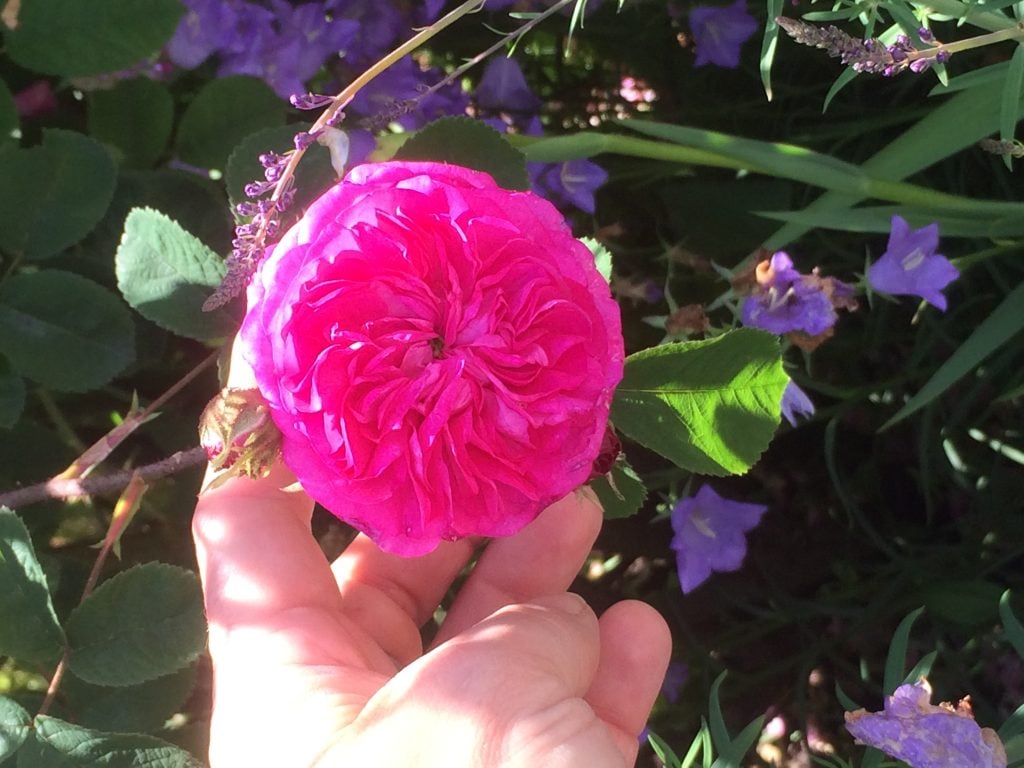
As you walk towards the garden, surrounded as it is with its high walls, you can smell the rose garden long before ever you get there. Wonderful.
There are said to be over 500 varieties of roses at Mottisfont, which is a stunning number and like a bag of Bassetts Liquorice Allsorts guaranteed to have something for everyone. I did see many of the old roses that we grow here at Reveley like Rosa ‘Francis E. Lester’.
And if I have got my facts right the collection was put together by Graham Stuart Thomas.
Reveley’s own rose garden design was put together by the well known Rose Growers Peter Beales. And indeed Beales gifted all the original roses to the Trust too.
Garden designers have a large bag of time tested tricks to use and going into Mottisfont’s Rose Garden it is the ‘big wow’ entrance. It is not often that I am left clueless as to which way to go first, in a garden, but I was here. With such a big sky vista within a walled garden, so much sweet scent to take in, colours calling you in every direction and a choice of paths. It’s quite a challenge for a simple lad like me!

Now if you are not the biggest rose fan in the world, and not everyone is, there is plenty of non-rose material mixed in to enjoy. Indeed the clever use of Agapanthus, Geranium and Peonies mingled with Pinks, Lilies, Phlox and Catmint, then there are Plume Poppies (one of my favourites) and Scabious grandiflora which is a very useful plant and of course Yew topiary to add height.
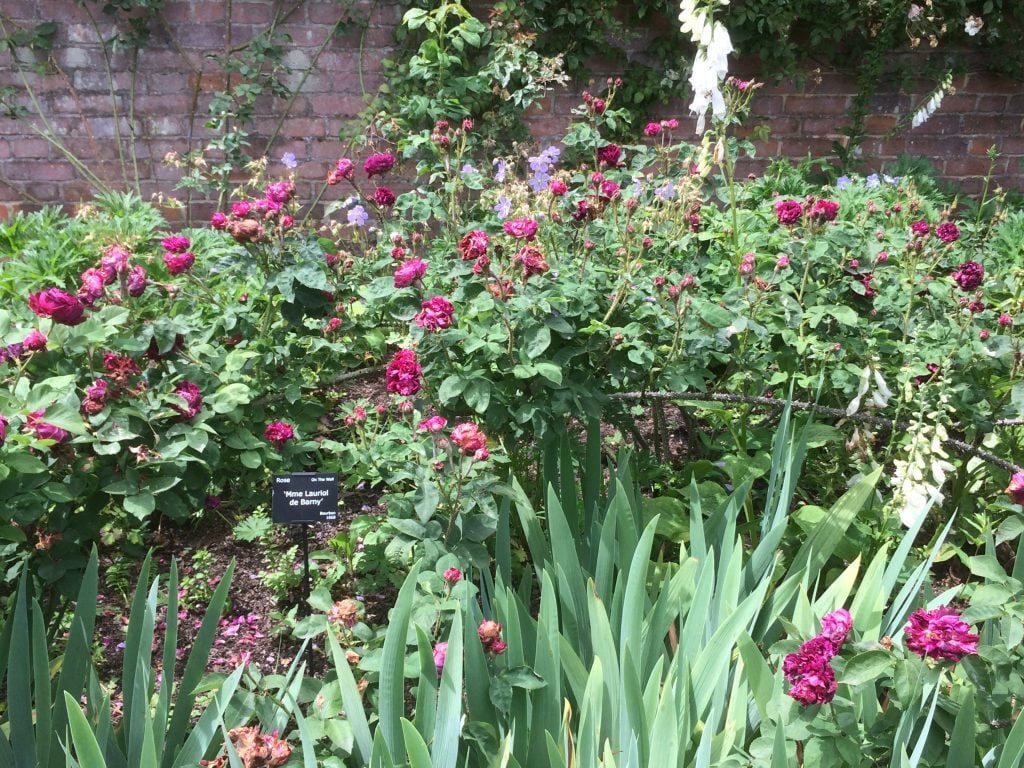
One of the interesting things which rose gardeners can do and I do too here at Reveley, is to bend a long stem over and stake it down. This breaks what is termed ‘apical dominance’. Here at Mottisfont you can see an example of Rosa ‘Mme. Lauriol de Barny’. The result is flowers right along the stem and not just at the top of the stem.
So you are probably wondering what were my favourite roses that I saw at Mottisfont? And that is a hard one. So here are a few:
Rosa ‘Perle d’ Or’: a Poly-pom rose from 1883.
Rosa ‘Mme Isacc Pereire’: a Bourbon rose from 1886.
Rosa ‘La Noblesse’: a Centifolia rose from 1856.
And finally Rosa ‘Chloris’: an Alba rose from 1820.
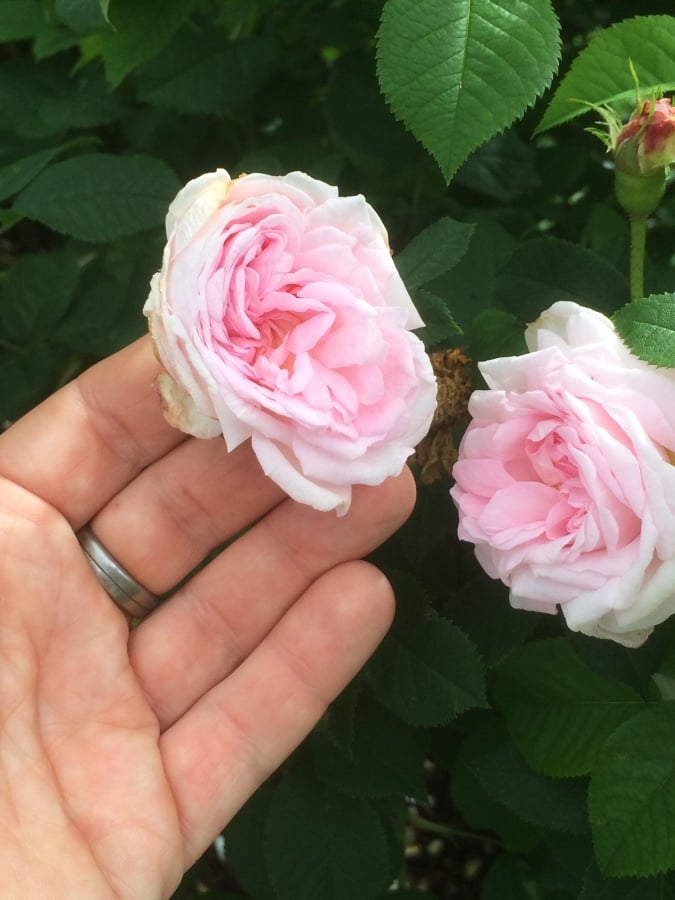
And so there we go, these are just a few of the things I saw. I hope you have enjoyed your day trip to Mottisfont.
www.nationaltrust.org.uk/mottisfont
And just to let you know that here at Reveley Lodge we are holding our own half day rose pruning tutorial this coming February.
Well what a bit of a mixed bag our summer was! Not much sun (although a lot more than my family in Scotland got – sorry mum!) but such a dry season. Courgettes that wouldn’t grow and sad roses. Lawns that packed their bags and went away for the summer and apple trees that didn’t fruit well. Hmmm.
But one of the oddities of the summer was one of our two pillars of sweet peas which has just kept on smelling sweet and giving us colour from the mid summer till into the beginning of October. Visitors it seems can’t help but make a bee line to have sniff of the perfume. And quite right too! The other pillar did probably exactly the same as yours and gave up the ghost a long time ago.
As you probably have noticed by now, I like projects! Gardens have always got projects on the go, big and small.
Our latest is to rebuild, what we call, The Clay Lane Lawn which runs along our east boundary. Basically it involved a bit of noise provided by the rotavator, a bit of perspiration provided by ten tonnes of topsoil and two wheelbarrows and a small collection of varying sized rakes and of course grass seed – aka fat pigeon feed! You will have to be a bit patient I know, but the results will become more evident in the spring as the growth really starts to develop.

We have both raised the soil level in some parts and reduced others to give a more pleasing look. Also as part of the process we cut back some tree roots so that should help with the lawns growth in future years. As you can see from one of the photos, we had a chestnut tree collapse, so what with the tree gone, soil levels altered and grass in areas it hasn’t been before this area should have a bit of a different feel about it.

With the help of some of our ever eager volunteers we managed to get the soil levels adjusted a bit. One amusing sight was 17 of us (volunteers, Lesley and I) walking in a line, heeling in the lawn. It looked more like an egg & spoon race than a horticultural exercise, but we got the job done in a jiffy.

We are looking forward to harvesting the pumpkins and squashes this week, which will be on sale shortly. This is always a bit of a highlight for Lesley and I.
And what’s next in the gardens at Reveley Lodge? Leaves of course… Autumn is on it’s way !
Here we are, and August is upon us!
Things have been going full steam ahead here at Reveley Lodge. Indeed all the planting out seems but a distant memory and new projects are now calling for our attention! But as Monty Don says: there are times when you just must stop to enjoy a passing moment because it may never come your way again. I recently had just one of those moments.
I was passing the large stone urn near the house conservatory when the sun hit the urn at an unusual angle and the plants were wonderfully backlit with what almost looked like haloes. It was indeed magical! And I don’t use those words often or lightly. Sadly, by the time I managed to quickly grab a camera and return to the scene, the moment had moved on and the lighting wasn’t quite the same. I did try to capture it but really that special moment had passed – the light had changed. And let’s face it, as you can see from my photo, I am not the greatest photographer in the world. My old Dad, who was a journalist / photographer wouldn’t have been impressed. Sorry Dad!
This spring my assistant, Lesley, had been asked by the Trust at Reveley to plant up the stone urn to try to recreate a scene from one of Mr Chewett’s paintings. You can compare it with the original painting, which is hanging in the Billiard Room. Please have a look and let us know what you think next time you are in for a cup of tea at Mabel’s. Anyway, I think Lesley has done a really good job, unlike my photograph.
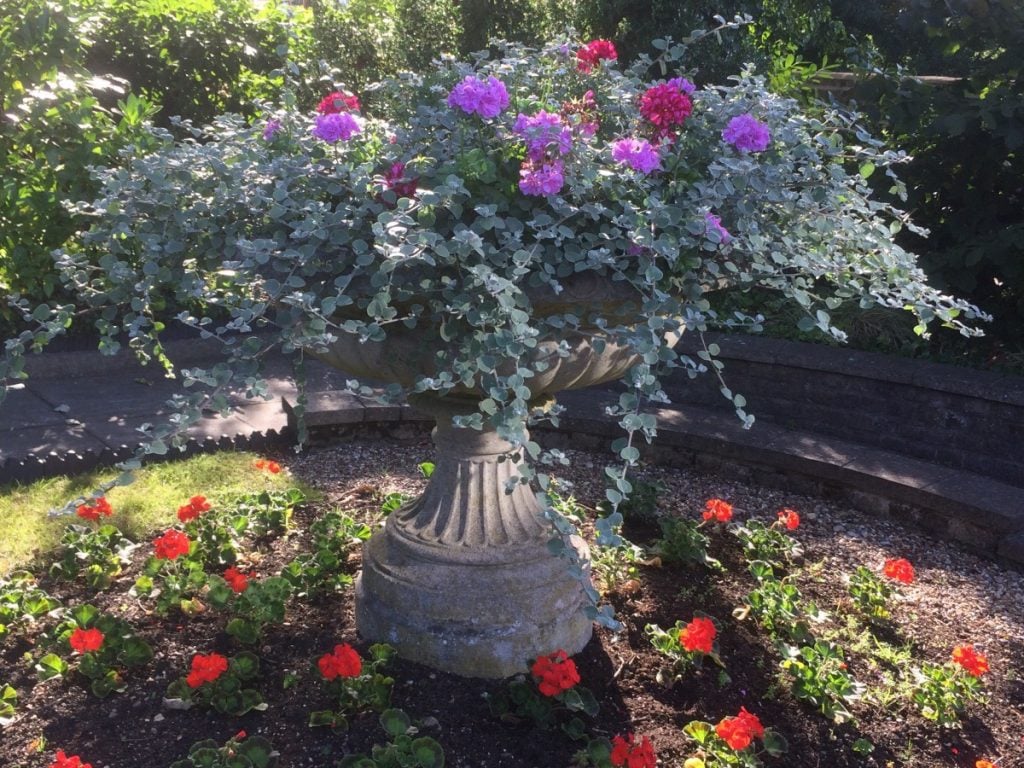
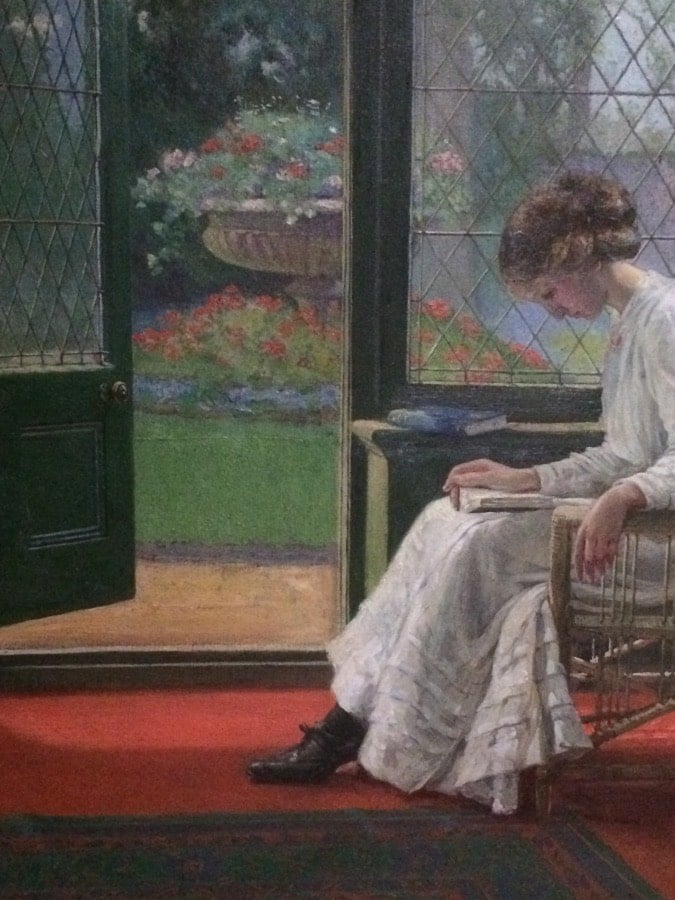
At the opposite end of the house, you will find what is at the moment ‘the colourful back gate area’. Here, hidden among all the different colours of foliage, you will see this delightful colour combination of Brunnera ‘Alexander’s Great’ and Solenostemon ‘Campfire’. The silver and green of the Brunnera set off the warm colours of the ‘Campfire’. Solenostemon is more commonly called Coleus, and yes, you can see why folks prefer the name Coleus! There are many Solenostemon that are, to be quite frank a bit gaudy, but there are some really good ones which can really add a spot of colour in a shady place. Coleus don’t really like full sun, it causes them to fade and lose their strong leaf colours.
Coleus are a quite difficult to overwinter as they tend to rot easily. But thankfully they aren’t too hard to grow from seed, or you can buy a couple in the spring. Definitely worth a whirl in my book!
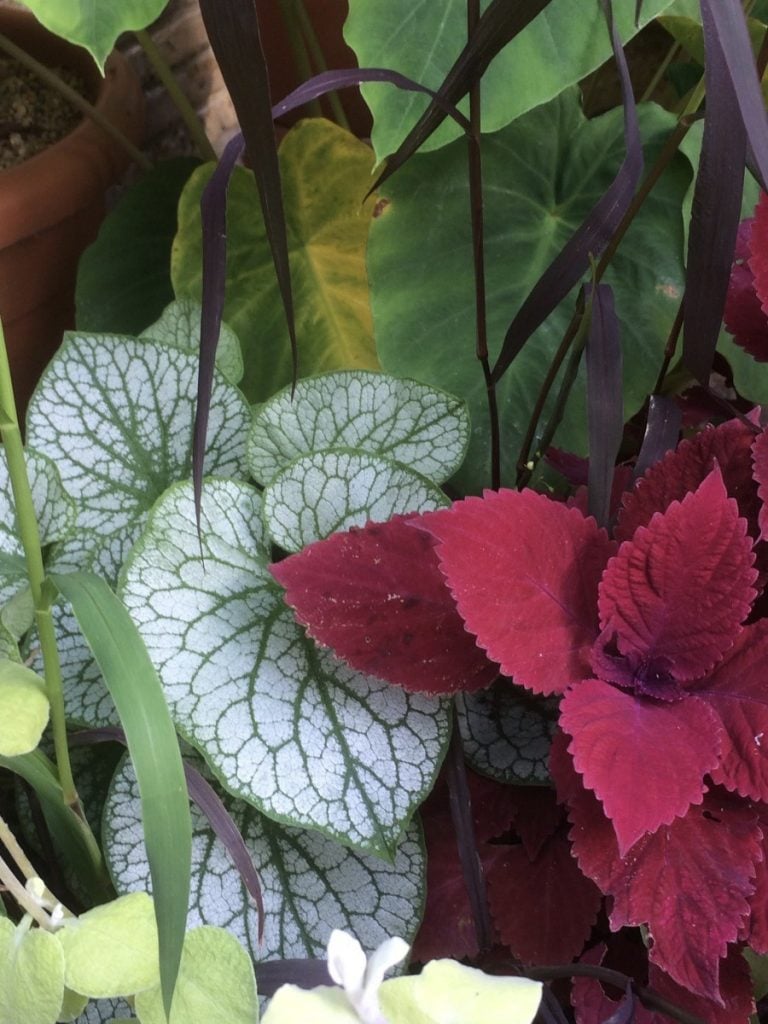
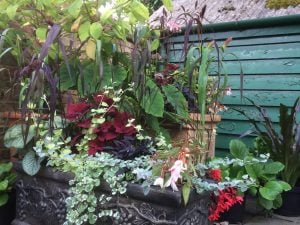
Enjoy the rest of the summer, And don’t forget to stop, enjoy and be thankful for those special moments as they come along. After all, it’s part of why we garden!
© Reveley Lodge Trust 2025 which is a company limited by guarantee (England 4772191) and a registered charity (1099935).